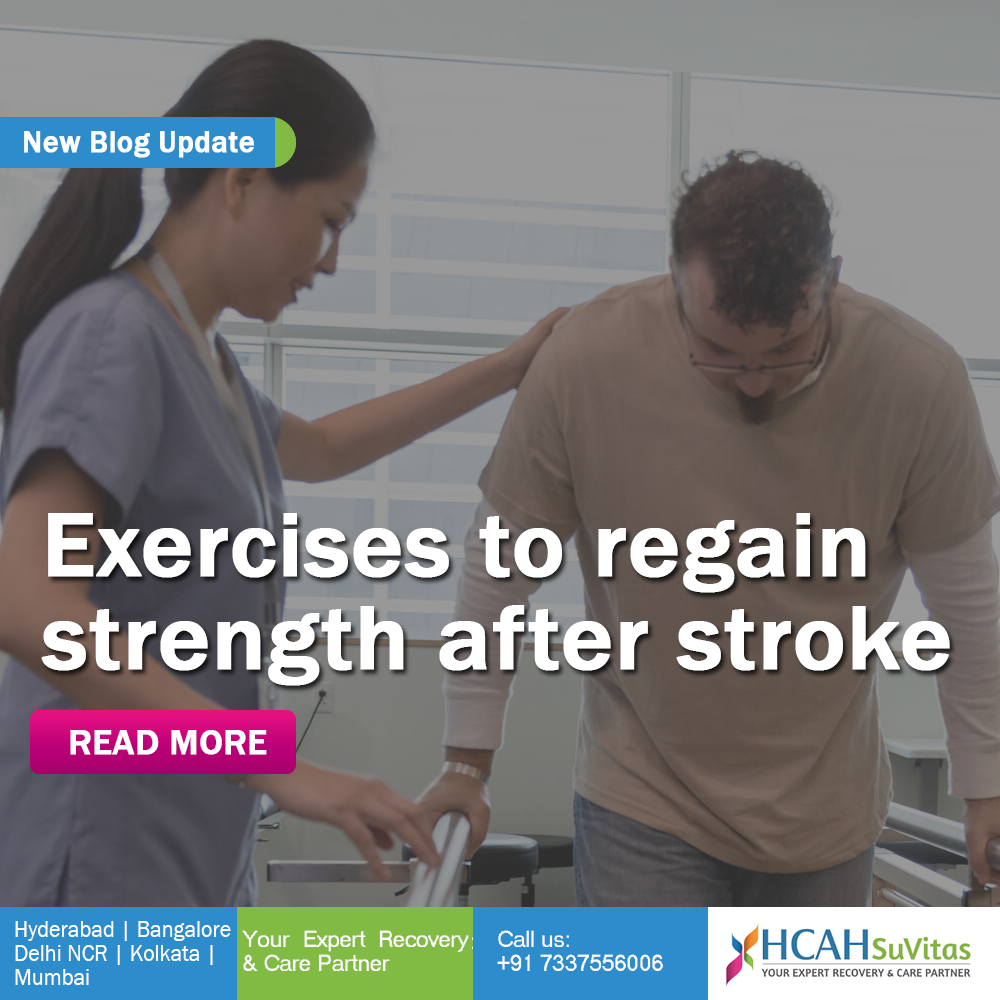7 Exercises to Regain Strength after Stroke
Stroke is one of the common causes of disability-adjusted life years (DALY) in the world. A structured stroke rehabilitation program combines interventions like Physiotherapy, Occupational Therapy, Cognitive Training, Nutrition Therapy, Psychological Counselling etc. to improve functional independence and overall quality of life. Exercising soon after stroke isn’t easy since one needs to overcome several physical and emotional barriers like fatigue, incoordination, altered sensation and depression. However, it is recommended to initiate a doctor-supervised exercise schedule at the earliest in order to regain highest possible functional independence. Physical inactivity could trigger risk of recurrent stroke. Exercises have both physical and psycho-social impact on the survivors.
Benefits of different types of exercises after stroke
- Aerobic exercises help in enhancing cardiac fitness, cognitive abilities, physical balance and endurance among other health outcomes.
- Specific strength training exercises can improve functionality & psychosocial aspects.
- Stretching helps in reducing spasticity, preventing joint contractures, muscle shortening, joint stiffness etc.
- Neuromuscular exercises target at improving activities of daily living (ADL).
- Yoga and other alternate interventions can help in promoting mental wellbeing, increasing muscle strength etc.
How much should a stroke survivor exercise?
Stroke impacts people differently. Depending on the severity and the parts of the body affected, your recovery partner/ doctor will prescribe a customized goal-oriented exercise regime. Ideally, stroke survivors must do moderate-intensity aerobic exercise for at least 30 minutes a day for a week or 25 minutes of rigorous exercises for three days a week. In an inpatient rehabilitation setting, exercises will be supported along with other recovery-oriented interventions throughout the day in different intervals. Please talk to the rehab experts before initiating these activities.
7 Exercises to regain strength after Stroke
- Table Circles- Clasp your palms together and hold an object like a water bottle on a tabletop. You could try something heavier too. Trace a large circle on the table in a churning motion. Try to make at least 10 circles like this. This exercise will help in promoting neuroplasticity and improving arm coordination.
- Wrist Curl and Movement- Place the palm of your affected hand downwards on the table. Using the palm of the non-affected hand, try to slide the palm of the affected hand to the left and then to the right. Next, try to bend the wrist up and down. Repeat both tasks slowly for 10 reps. Wrist movement exercises help in improving range of motion and strengthening the forearm.
- Lying Rotation- Lie down on your back with knees bent. Seek a caregiver’s/therapist’s help. Now slowly let your knees fall to the right. Twist your truck. Next, repeat to the left. This activity can help in strengthening hip and core muscles.
- Seated Push up- Sit on the ground with knees bent and palms on the floor. Now keeping your fingers pointed to the front, slowly push your hands down to lift your bottom off the floor. You can repeat this activity as you grow stronger. This is an advanced form of exercise to train your range of motion.
- Side lying Clams- Lie on your side with knees bent, keeping feet together. Now slowly lift the upper knee toward the ceiling and hold for 10 seconds and then bring it down. Don’t roll your hips back. This exercise will challenge a large number of core muscles and help in building more strength.
- Bilateral leg Cycling- Lie on the floor. Lift the legs off the ground as if in a cycling position. Slowly start cycling in the air. Doing this can help in regaining a strong, healthy core.
- Behind the neck/waist cup pass- Sit on a chair next to a table in front. Place some disposable plastic/ paper cups stacked on the table. Now, looking straight to a point in the front, grab the first cup and pass it on to your other hand behind your neck. Place the cup on the table with the other hand. Continue doing this until you have passed all paper cups in the stack. Next, repeat the same activity by passing the cups behind your waist, along the top of your pants line. This is an advanced shoulder exercise to improve shoulder mobility and control.
Stroke-related disabilities needn’t be permanent. By initiating an early inpatient rehabilitation program, survivors can get back to their near to normal lives. Even after undergoing the rehabilitation program, it is recommended to maintain an active lifestyle by continuing to perform goal-oriented exercises, following a healthy diet along with any required medication to take better control of their recovery. Talk to your doctor or rehabilitation experts to initiate your personalized post stroke exercise program.

